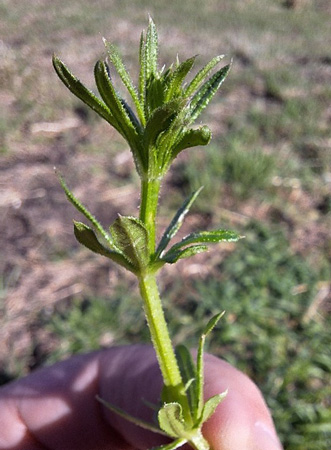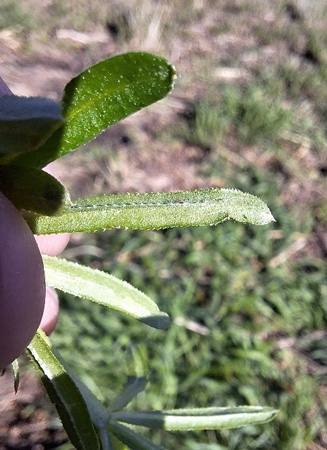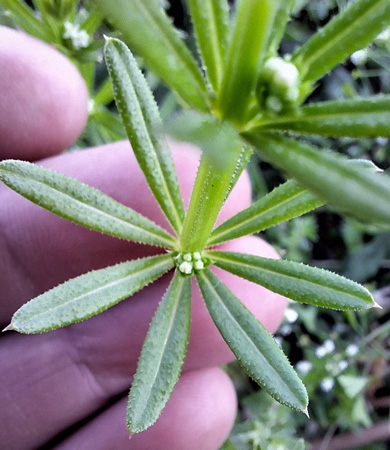A question recently came in about controlling catchweed bedstraw in a smooth bromegrass hay meadow (Figure 1). Catchweed bedstraw (Galium aparine), also known as cleavers, is a member of the madder family, which also includes coffee, gardenias, and several other ornamental plants. There are some other bedstraw species, but they are of little agronomic importance. As the name implies, this plant ‘catches’ and clings to objects as a result of bristles on stems, leaves, and fruits. Catchweed bedstraw and related species were historically used as mattress filling (bedstraw).

Figure 1. The growth habit of catchweed bedstraw. Photos by Sarah Lancaster, K-State Research and Extension.
Ecology
Catchweed bedstraw is a summer or winter annual weed native to North America and found throughout most of the world. It grows in a variety of habitats, including forests, prairies, and cultivated fields. Catchweed bedstraw is often found in moist, shady areas, but can tolerate dry soils once established. It can also tolerate freezing temperatures while in the vegetative growth stage. Catchweed bedstraw grows quickly and can flower in as little as eight weeks after germination.
Identification
Catchweed bedstraw cotyledons are 1/2 to one inch, oblong to egg-shaped, with slightly notched tips. Stems are square and grow up to 6 feet long, rarely branching (Figure 2). They grow along the ground and can climb over other plants as a result of being covered in bristles.

Figure 2. Catchweed bedstraw has square stems with few branches. The stems are covered in bristles. Photo by Sarah Lancaster, K-State Research and Extension.
Leaves are approximately ½ to 1 ¼ inches long by about 1/10 inch wide with a sharp point at the tip. They clasp the stem (sessile) and grow in whorls of four to eight. Leaves are covered in hooked bristles, especially the upper leaf surface, leaf margins, and lower midrib (Figure 3).

Figure 3. The midrib and leaf margins of catchweed bedstraw are lined with hooked bristles. Photo by Sarah Lancaster, K-State Research and Extension.
Inconspicuous, white or pale green flowers have four petals and measure about 1/10 inch across (Figure 4). They grow on short branches in groups of 3 to 5, found either at leaf axils or at the end of the stem. Fruits are brown to black, spherical to kidney-shaped, and are covered in hooked bristles, which hold them together in pairs. Seeds are retained inside the fruit.

Figure 4. Catchweed bedstraw has inconspicuous flowers. Also note the sharp points at the ends of the leaves. Photo by Sarah Lancaster, K-State Research and Extension.
Management
Prevention is an important management tactic for catchweed bedstraw. It can be introduced in seed, hay, or manure. Seeds remain viable after passage through the digestive tract of cattle, horses, pigs, goats, and birds.
Established catchweed bedstraw can be controlled by products that contain combinations of fluroxypyr (Starane, others), halauxifen (Elevore, others), quinclorac (Facet, others), dicamba, MCPA, carfentrazone (Aim), or glyphosate are labeled for catchweed bedstraw control. Group 2 herbicides sulfosulfuron (Outrider, others), and florasulam (Orion, others) are also labeled; however, resistance to ALS-inhibiting herbicides has been documented in catchweed bedstraw populations around the world.
Mowing alone is not an effective control option, as cutting at 2 to 3 inches may increase biomass accumulation. Likewise, tillage may increase the population density as a result of seed burial.
The use of trade names is for clarity to readers and does not imply endorsement of a particular product, nor does exclusion imply non-approval. Always consult the herbicide label for the most current use requirements.
Sarah Lancaster, Extension Weed Management Specialist
slancaster@ksu.edu